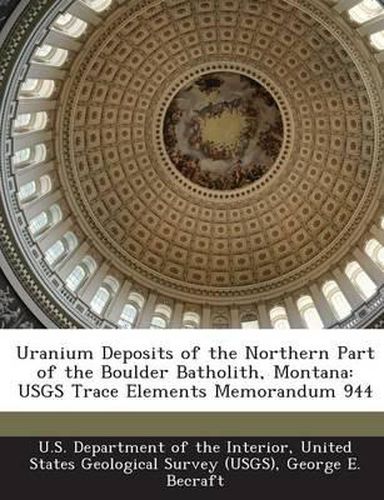Readings Newsletter
Become a Readings Member to make your shopping experience even easier.
Sign in or sign up for free!
You’re not far away from qualifying for FREE standard shipping within Australia
You’ve qualified for FREE standard shipping within Australia
The cart is loading…






Uranium minerals and radioactivity anomalies occur in many silver-lead veins and chalcedony veins and vein zones in the Boulder batholith of southwestern Montanao Pitchblende has been identified in a few silver-lead veins. These veins occupy shear zones along which there is no evidence of large-scale lateral displacement. The wall rock adjacent to the veins is intensely silicified and sencitized quartz monzonite and granodiortte. The veins have yielded substantial quantities of lead, silver, zinc, and gold. The silver-lead veins consist principal1y of galena, spha1erite, tetrahedrite, cha1copyrite and pyrite in a gangue of light to dark gray quartz, altered rock, gouge, and subordinate chalcedony and carbonate minerals. No anomalous radioactivity nor uranium minerals have been found in similar veins in pre-batholithic rocks of the area. Chalcedony veins and vein zones, some of which are ttraniferous, are distinctly different from the silver-lead veins and, with a single except1on, are known only in the batholith. The chalcedony vein zones consist of one or more discontinuous stringers or veins of cha1cedony and microcrystalline quartz in silicified and sericitized quartz monzonite and granodiorite, and in less strongly altered alaskite. On1y small amounts of silver ore have been produced from these chalcedony veins and vein zones. All of the veins are ear1y Tertiary in age, but the silver-lead veins probably are older than the chalcedony veins. Uranium is closely associated with chalcedory and microcrystalline quartz in both types of veins. This association suggests that all of the uranium in the area is of the same age. If so, some of the silver-lead veins must have been reopened during the period of chalcedony vein formation.
$9.00 standard shipping within Australia
FREE standard shipping within Australia for orders over $100.00
Express & International shipping calculated at checkout
Uranium minerals and radioactivity anomalies occur in many silver-lead veins and chalcedony veins and vein zones in the Boulder batholith of southwestern Montanao Pitchblende has been identified in a few silver-lead veins. These veins occupy shear zones along which there is no evidence of large-scale lateral displacement. The wall rock adjacent to the veins is intensely silicified and sencitized quartz monzonite and granodiortte. The veins have yielded substantial quantities of lead, silver, zinc, and gold. The silver-lead veins consist principal1y of galena, spha1erite, tetrahedrite, cha1copyrite and pyrite in a gangue of light to dark gray quartz, altered rock, gouge, and subordinate chalcedony and carbonate minerals. No anomalous radioactivity nor uranium minerals have been found in similar veins in pre-batholithic rocks of the area. Chalcedony veins and vein zones, some of which are ttraniferous, are distinctly different from the silver-lead veins and, with a single except1on, are known only in the batholith. The chalcedony vein zones consist of one or more discontinuous stringers or veins of cha1cedony and microcrystalline quartz in silicified and sericitized quartz monzonite and granodiorite, and in less strongly altered alaskite. On1y small amounts of silver ore have been produced from these chalcedony veins and vein zones. All of the veins are ear1y Tertiary in age, but the silver-lead veins probably are older than the chalcedony veins. Uranium is closely associated with chalcedory and microcrystalline quartz in both types of veins. This association suggests that all of the uranium in the area is of the same age. If so, some of the silver-lead veins must have been reopened during the period of chalcedony vein formation.